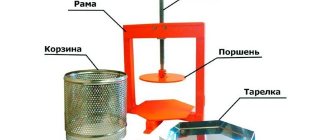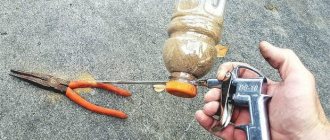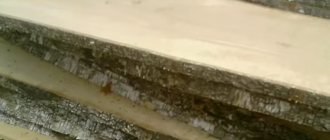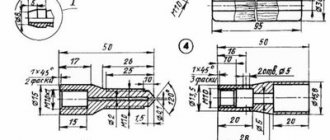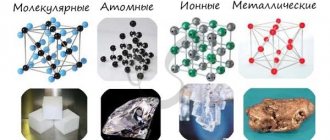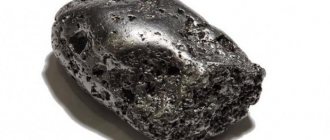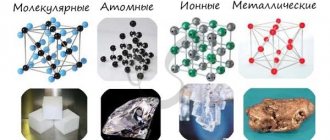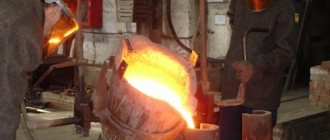When was it open
The history of man's acquaintance with iron begins with Space. Judging by the ancient (for example, ancient Egyptian) names of the element, it was meteorite iron. Hittite texts refer to him as "fallen from the sky."
Man has been using metal for 6 thousand years.
Archaeologists have unearthed tools used by the ancient Sumerians and Egyptians. They are made from meteorite iron.
Iron products conquered the world. The poems of Homer's Iliad are dedicated to metal, and it is mentioned by Aristotle and Strabo.
The ancient name of iron is due to its celestial origin: “sider” (“starry”).
Scientists are constantly exploring the potential of metal. Thus, in 1868, the Russian scientist D.K. Chernov discovered crystalline modifications of matter.
Manufacturers
Today, there are large deposits of iron ore in different countries, which are the basis for the production of the world's steel reserves. In particular, Russia and Brazil account for 18% of world steel production, Australia – 14%, Ukraine – 11%. The largest exporters are India, Brazil, and Australia. Please note that metal prices are constantly changing. Thus, in 2011, the cost of one ton of metal was 180 US dollars, and by 2016 the price was fixed at 35 US dollars per ton.
Physico-chemical characteristics
Iron is not a particularly hard metal (4-5 on the Mohs scale).
Physical and chemical properties are determined by impurities and microclimate:
- Reacts with metals at elevated temperatures.
- Pure iron is ductile and does not oxidize in water or air.
- When exposed to dry air (not hotter than 200°C), it becomes covered with a matte oxide film. It prevents metal corrosion.
- Endowed with magnetic properties. By this characteristic, iron can be easily distinguished from other metals.
A substance with the formula FeO•nH2O is ordinary rust.
- The crystal lattice is cubic, but changes structure depending on temperature.
- Iron, elevated temperatures plus water form sulfides, halides, phosphides, titanides, nitrides.
- Insoluble in alkalis.
- Interaction with acids depends on concentration. Dilute ones dissolve the metal, concentrated ones create an oxide film-shield.
Hydrothermal spring with ferruginous water.
Iron oxides color water brown. Wet or hot iron becomes covered with rust. Carbon makes it brittle. These disadvantages limit the use of the metal.
| Properties of the atom | |
| Name, symbol, number | Iron / Ferrum (Fe), 26 |
| Atomic mass (molar mass) | 55.845(2) a. e.m. (g/mol) |
| Electronic configuration | [Ar] 3d6 4s2 |
| Atomic radius | 126 pm |
| Chemical properties | |
| Covalent radius | 117 pm |
| Ion radius | (+3e) 64 (+2e) 74 pm |
| Electronegativity | 1.83 (Pauling scale) |
| Electrode potential | Fe←Fe3+ −0.04 V Fe←Fe2+ −0.44 V |
| Oxidation states | 6, 3, 2, 0 |
| Ionization energy (first electron) | 759.1 (7.87) kJ/mol (eV) |
| Thermodynamic properties of a simple substance | |
| Density (at normal conditions) | 7.874 g/cm³ |
| Melting temperature | 1812 K (1538.85 °C) |
| Boiling temperature | 3134 K (2861 °C) |
| Ud. heat of fusion | 247.1 kJ/kg 13.8 kJ/mol |
| Ud. heat of vaporization | ~6088 kJ/kg ~340 kJ/mol |
| Molar heat capacity | 25.14 J/(K mol) |
| Molar volume | 7.1 cm³/mol |
| Crystal lattice of a simple substance | |
| Lattice structure | cubic body-centered |
| Lattice parameters | 2.866 Å |
| Debye temperature | 460 K |
| Other characteristics | |
| Thermal conductivity | (300 K) 80.4 W/(mK) |
| CAS number | 7439-89-6 |
Iron production on a moving grate
The process of producing iron on a moving grate (Fig. 43) is somewhat reminiscent of the operation of a sintering machine. In this case, the converted gas passes from top to bottom through the charge layer.
Rice. 43. Scheme of the process of producing iron on a moving grate: 1 – roasting conveyor machine, 2 – charge, 3 – drying zone, 4 – roasting and reduction zone, 5 – electric furnace, 6 – ladle for liquid metal, 7 – ladle for slag
There is a variation of the process for producing iron on a moving grate, when a solid reducing agent (coal, coke, etc.) is used instead of converted gas.
In this case, the raw pellets in the head part of the installation are dried with recirculated gases, after which the pellets enter the firing zone, where, as a result of the suction of hot gases, heating and reduction of iron oxides occur. The main advantage of this process is the ability to feed non-roasting pellets into the recovery plant. The disadvantage of this process is that the sponge iron is contaminated with waste rock, sulfur and phosphorus from the solid fuel.
Iron in nature
Iron is the fourth most abundant element on the planet and the second among metals (after aluminum). But the content is uneven: 86% of the reserves are concentrated in the planet’s core, the rest is shared by the mantle and crust.
Native iron is rare in nature; it is almost always minerals.
Native iron
There are three hundred of them, the most famous and rich in iron (% content in composition):
- Magnetite (magnetic iron ore) – 72.
- Hematite (red iron ore) – 70.
- Lepidocrocite, goethite – 63 each.
- Limonite (brown iron ore) – 62.
- Siderite (spar iron ore) – 48.
Iron is found in all living organisms.
The second source is meteorites.
A quarter of the mass of stone meteorites and 91% of iron meteorites is iron.
Receiving technology
Iron ore (magnetite and hematite) is sent to work: to a processing or metallurgical plant.
Iron ore
Pig iron is smelted in a blast furnace. At 1610°C, the mixture (sinter, pellets) with flux is loaded and blown with hot air. This allows you to remove impurities and separate slag.
The main methods of producing steel:
- Martenovsky. Molten cast iron, ore, and scrap are melted at 2100°C.
If necessary, alloying additives are added at the end of the melt.
- Oxygen converter . The cast iron mass in the furnace is blown with air under pressure. A mixture of oxygen and air or pure oxygen is used (for steels with premium characteristics).
- Electric melting. Cast iron is burned in an electric furnace at 2250°C. The method is used for smelting alloy and other special grades of steel.
- Straight. The iron-rich pellets are loaded into the furnace. Blow with hydrogen at 1050°C.
Hardening steel—heating until hot and cooling—makes it ductile and hard.
The production of pure metal is based on the electrolysis of molten salts of the substance.
An iron alloy containing less than 2% carbon is steel. More than 2% carbon is cast iron.
Production
There are many quarries in Russia and the world where iron ore is mined. These are huge and heavy stones that are quite difficult to get out of the quarry, since they are part of one large rock. Directly at the quarries, explosives are placed in the rock and detonated, after which huge pieces of stones fly in different directions. Then they are collected, loaded onto large dump trucks (such as BelAZ) and transported to the processing plant. Iron will be extracted from this rock.
Sometimes, if the ore is on the surface, it is not necessary to mine it. It is enough to split it into pieces in any other way, load it onto a dump truck and take it away.
Where is it used?
It’s hard to imagine everyday life without metal: iron is practical, reliable, and cheap. Perhaps someday it will be replaced by plastic. Today the advantages of iron material are at a premium.
Ultrapure iron
Industry
Iron has found uses in all forms. Alloys are the basis of materials in demand by industry. Powder is purchased in tons for welding, pyrotechnics, and printers. Compounds - the basis of mineral paints, pigments in the production of textiles and inks.
No industry can do without it:
- Mechanical engineering. The body of machines and mechanisms, especially for working in extreme conditions.
- Construction. Load-bearing structures of buildings, structures (bridges, mobile communication towers, etc.), fittings. Roofing material, corrugated sheets, metal tiles.
- Electrical engineering. Cores of electromagnets, armatures of electric machines, battery plates.
- Communications. Industrial and domestic pipelines for pumping steam, water, gas, and oil are made of steel and cast iron. This is the sheath of power cables.
Iron is the anode in iron-nickel, iron-air batteries. Household and professional tools are made from steel.
Other areas
Metal is used in science, medicine, and everyday life:
- Cleaning of drains.
- Component of gart (printing font).
- Kitchen utensils, tableware.
- Doors, locks.
- Ultra-fine magnetite (metal oxide) powder is used to fill black-and-white printers.
- Furniture of avant-garde styles.
- Anemia is treated with iron supplements.
- Gardeners and builders destroy the fungus with a mixture of copper and iron sulfate (septate metal sulfate).
Artificial radioactive isotopes are a marker in the analysis of chemical, technological and biological processes.
Biological effects
For humans, iron as a microelement (0.02%) is of special importance: it regulates cellular respiration and is part of the blood.
Health Importance
The adult human body contains 3.5 grams of iron. Of these, three quarters are included in the hemoglobin of the blood, the rest is distributed to other structures of the body.
Lack of microelement causes anemia in humans or animals, chlorosis in plants.
Nutrition
Iron is supplied to the body by food.
The foods richest in micronutrients are found in all food groups:
- Bread, cereals.
- Liver, meat.
- Eggs.
- Beets, leafy greens.
- Legumes.
- Dried fruits, nuts, seeds.
Foods contain different types of iron: heme and non-heme. Heme contains the “animal” assortment, while non-heme contains the plant variety.
Need
Daily iron requirement (mg):
- children – 4-18;
- women – 18;
- men – 10.
During pregnancy, the norm doubles. More is required for anemic people and donors.
It is easier for the body to absorb heme iron, so vegans or vegetarians need 30-33 mg daily.
The danger of oversupply
However, an excess of the substance is not welcome, since it “suppresses” the formation of antioxidants in the body.
The use of water with an iron content of more than 2 mg per liter is undesirable. If the metal content is more than 200 mg, the water is toxic.
According to Russian standards, a liter of water should contain no more than 0.3 mg of iron.
Iron ore beneficiation
As stated, there are several types of ores. Rich ones can be processed directly after extraction from the earth's crust, others need to be enriched. In addition to the beneficiation process, ore processing includes several stages, such as sorting, crushing, separation and agglomeration.
Today there are several main methods of enrichment:
It is used to clean ores from by-products in the form of clay or sand, which are washed out using high-pressure water jets. This operation makes it possible to increase the amount of iron content in low-grade ore by approximately 5%. Therefore, it is used only in combination with other types of enrichment.
It is carried out using special types of suspensions, the density of which exceeds the density of waste rock, but is inferior to the density of iron. Under the influence of gravitational forces, the by-products rise to the top, and the iron falls to the bottom of the suspension.
The most common beneficiation method, which is based on different levels of perception by ore components of the influence of magnetic forces. Such separation can be carried out with dry rock, wet rock, or in an alternate combination of its two states.
To process dry and wet mixtures, special drums with electromagnets are used.
For this method, crushed ore in the form of dust is dipped into water with the addition of a special substance (flotation reagent) and air. Under the influence of the reagent, the iron joins the air bubbles and rises to the surface of the water, while the waste rock sinks to the bottom. Components containing iron are collected from the surface in the form of foam.
If you find an error, please select a piece of text and press Ctrl+Enter.
Author : Mikhailov Leonid
Leaders:
We have long been interested in the history of the development of metallurgy in our region; this history is connected mainly with the Batashov brothers, who owned factories in our district. In previous years, we studied their factories in Ilev [1], Snoved [2], as well as in the Ryazan and Vladimir regions [3]. It is known that at the Batashov factories there was a full metallurgical cycle: from ore mining to the manufacture of iron products. In the process of studying the history of factories, we were very interested in the development of metallurgy technology, and we devoted this work to the ancient process of producing iron.
Development of iron metallurgy
The first iron objects known to archaeologists date back to the 10th century BC. The first iron was highly valued and was not immediately used for making tools. The most ancient method of obtaining iron from ore was the so-called cheese-blowing method, in which iron ore and coal are loaded into a forge or furnace, during the combustion of which iron is partially reduced from the ore. “Raw”, unheated air was pumped into the forge, which is where the name of the technique itself came from. Melting of crushed iron ore in a forge mixed with charcoal occurred at high temperatures. As the coal burned out, solid grains of iron, recovered from the ore, sank to the bottom of the furnace and, when welded, formed a spongy clot called kritsa. To compact the metal, the frozen kritsa removed from the forge was forged many times, obtaining a monolithic piece of iron weighing up to 5-6 kg. Metallurgy products were given a round, flat cake shape.
Read also: DIY metal ballerina
Subsequently, in the production of iron, primitive forges were replaced by blast furnaces: these furnaces are larger in size, more productive, and also reach higher temperatures. The product of a blast furnace is cast iron (iron with a high carbon content), which is then processed into iron or steel [4-6].
Goals and objectives of the work
Purpose of the work : to reconstruct the cheese-making method of obtaining iron in modern conditions.
Tasks:
1) Find the ore needed to smelt iron.
2) Build a furnace that matches the ancient models as closely as possible.
3) Carry out the melting process.
4) Analyze the obtained samples.
Description of iron production in the literature
One of the sources from which we restored the ancient method of obtaining iron was Jules Verne’s book “The Mysterious Island” [7]. The book describes how several people ended up on a desert island wearing the same clothes and gradually created various amenities for themselves, including smelting iron for their own needs.
Their smelting method was called “Catalan”. It was as follows. “The Catalan method in its truest sense requires the construction of furnaces and crucibles into which ore and coal are placed in layers.” But the hero of the book, engineer Cyrus Smith, intended to do without these structures. He erected “a cubic structure of coal and ore and directed a stream of air into the center of it.” “Coal, as well as ore, was easily collected nearby directly from the surface of the earth. First, the ore was crushed into small pieces and cleaned of dirt by hand. Then the coal and ore were piled up layer by layer, just as a coal miner does with the wood he wants to burn. Thus, under the influence of the air pumped by the bellows, the coal had to turn into carbon dioxide and then into carbon monoxide, which was to restore the magnetic iron ore, that is, take oxygen away from it.” The air blast was organized using seal skin bellows.
The iron was obtained, but “it proved difficult. It took all the patience and all the ingenuity of the colonists to successfully implement it. In the end, it was successful, and an iron blank was obtained in a spongy state, which still had to be forged in order to expel the liquid slag from it. Thus, a rough but usable metal was obtained.”
We tried to bring into reality what was described by Jules Verne. The main difference between our method was that we used a stove.
Process of obtaining iron
On June 3, 2010, we went to explore the surroundings of the village of Elizaryeva, where, as we knew, there were iron ore mines. From Sarov we got to the place in about 20 minutes. Having reached the place, we went to search for ore, which should have been located in the area of old mines. We found the most ore where there was no grass and a layer of soil was removed (fire trench) or compacted (road). It was in the trench that we found most of the ore of various sizes, up to 15*10*10 cm (approximately). The ore was mostly gray and brown in color. The predominant ore is brown in color. We collected a bucket of ore. We also saw about a dozen remains of pipes, which were filled up and already overgrown with grass.
Old pipe near the village of Elizaryeva
We decided to crush the ore to a size of no more than 1 cm 3 to make it easier to melt. We crushed all the ore in the bucket and got about 3/5 of the bucket of crushed ore.
The process of grinding ore by the author of the work
Fragments of sand-lime bricks were used for the furnace. The furnace was laid using a mixture of cement and sand. We mixed the mortar and stacked the bricks row by row in the oven, holding them together with the mortar.
The stove was preheated by burning wood in it for an hour and a half.
We poured ore into the heated furnace, and then charcoal, purchased at the store, in layers. We had to achieve a temperature of 900 degrees Celsius, so in addition to the conditions provided to us by nature, we had to use vacuum cleaners for blowing (imitation bellows). There were two vacuum cleaners and they turned on one by one, working for 30 minutes without a break. But after an hour of melting, the furnace began to crack, since the sand-lime brick could not withstand such a high temperature. But despite the fact that it cracked, the melt did not fall apart in 2 hours and 30 minutes. During the melting process, we measured the temperature inside the furnace using a special device. It ranged from 800 to 1300 degrees Celsius. The whole preparation process took 4 hours.
Air blast. In the photo - Valentina Fedorovna Kuznetsova - owner of the vacuum cleaner
Loading ore and coal
Temperature measurements using a pyrometer are carried out by Alexey Kovalev
After disassembling the stove the next day, we removed from it gray pieces with a faint metallic sheen.
Samples of the resulting metal
Apparently a metallurgical reaction took place (before and after)
An attempt to forge the resulting metal
Following the method described by Jules Verne, samples of the resulting metal had to be forged. To do this, we took them to the forge, where the blacksmith heated them in a forge, but under his hammer our metal crumbled. An examination carried out in one of the VNIIEF laboratories showed that the resulting substance consists of 20% iron, and the rest is iron oxides.
We received the metal, but it turned out to be unsuitable for making any products.
What was our possible mistake? We posted our experience online and received many comments [8], some of which were valuable.
In particular, a user with the nickname 3meys told us:
“When smelting ore at high temperatures, the temperature should be
900 degrees and as little unburned oxygen as possible so that it does not oxidize the metal back.”
From this we conclude that we had a temperature slightly higher than necessary, and the reduced iron oxidized, which explains the brittleness and porosity of the samples we obtained.
However, we believe that we have achieved our goals - we carried out the smelting, as a result of which the metallurgical process was carried out. With our experiment, we are closer to understanding ancient metallurgical production.
The author and managers thank the employees of the Institute of Explosion Physics of the Russian Federal Nuclear Center-VNIIEF Alexey Evgenievich Kovalev for measuring temperature using a pyrometer and Mikhail Igorevich Tkachenko for conducting X-ray diffraction analysis of ore and metal.
Application
Comparison of technology today, in the 17th - 18th centuries (yesterday) and ours
